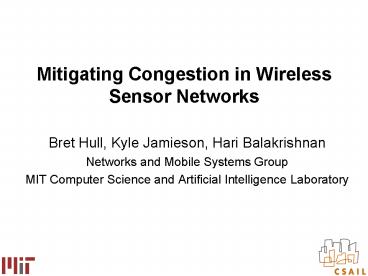Mitigating Congestion in Wireless Sensor Networks - PowerPoint PPT Presentation
Title:
Mitigating Congestion in Wireless Sensor Networks
Description:
MIT Computer Science and Artificial Intelligence Laboratory ... Investigating congestion. 55-node Mica2 sensor network. Multiple hops. Traffic pattern ... – PowerPoint PPT presentation
Number of Views:86
Avg rating:3.0/5.0
Title: Mitigating Congestion in Wireless Sensor Networks
1
Mitigating Congestion in Wireless Sensor Networks
- Bret Hull, Kyle Jamieson, Hari Balakrishnan
- Networks and Mobile Systems Group
- MIT Computer Science and Artificial Intelligence
Laboratory
2
Congestion is a problem in wireless networks
- Difficult to provision bandwidth in wireless
networks - Unpredictable, time-varying channel
- Network size, density variable
- Diverse traffic patterns
- The result is congestion collapse
3
Outline
- Quantify the problem in a sensor network testbed
- Examine techniques to detect and react to
congestion - Evaluate the techniques
- Individually and in concert
- Explain which ones work and why
4
Investigating congestion
- 55-node Mica2 sensor network
- Multiple hops
- Traffic pattern
- All nodes route to one sink
- B-MAC Polastre, a CSMA MAC layer
16,076 sq. ft.
100 ft.
5
Congestion dramatically degrades channel quality
6
Why does channel quality degrade?
- Wireless is a shared medium
- Hidden terminal collisions
- Many far-away transmissions corrupt packets
Receiver
Sender
7
Per-node throughput distribution
8
Per-node throughput distribution
9
Per-node throughput distribution
10
Per-node throughput distribution
11
Goals of congestion control
- Increase network efficiency
- Reduce energy consumption
- Improve channel quality
- Avoid starvation
- Improve the per-node end-to-end throughput
distribution
12
Hop-by-hop flow control
- Queue occupancy-based congestion detection
- Each node has an output packet queue
- Monitor instantaneous output queue occupancy
- If queue occupancy exceeds a, indicate local
congestion
13
Hop-by-hop flow control
- Hop-by-hop backpressure
- Every packet header has a congestion bit
- If locally congested, set congestion bit
- Snoop downstream traffic of parent
- Congestion-aware MAC
- Priority to congested nodes
Packet
14
Rate limiting
- Source rate limiting
- Count your parents number of descendents
- Limit your sourced traffic rate, even if
hop-by-hop flow control is not exerting
backpressure
15
Related work
- Hop-by-hop flow control
- Wan et al., SenSys 2003
- ATM, switched Ethernet networks
- Rate limiting
- Ee and Bajcsy, SenSys 2004
- Wan et al., SenSys 2003
- Woo and Culler, MobiCom 2001
- Prioritized MAC
- Aad and Castelluccia, INFOCOM 2001
16
Congestion control strategies
No congestion control Nodes send at will
Occupancy-based hop-by-hop flow control Detects congestion with queue length and exerts hop-by-hop backpressure
Source rate limiting Limits rate of sourced traffic at each node
Fusion Combines occupancy-based hop-by-hop flow control with source rate limiting
17
Evaluation setup
- Periodic workload
- Three link-level retransmits
- All nodes route to one sink using ETX
- Average five hops to sink
- 10 dBM transmit power
- 10 neighbors average
16,076 sq. ft.
100 ft.
18
Metric network efficiency
Interpretation the fraction of transmissions
that contribute to data delivery.
- Penalizes
- Dropped packets (buffer drops, channel losses)
- Wasted retransmissions
19
Hop-by-hop flow control improves efficiency
20
Hop-by-hop flow control conserves packets
No congestion control
Hop-by-hop flow control
21
Metric imbalance
Interpretation measure of how well a node can
deliver received packets to its parent
- ?1 deliver all received data
- ? ? more data not delivered
i
22
Periodic workload imbalance
23
Rate limiting decreases sink contention
No congestion control
With only rate limiting
24
Rate limiting provides fairness
25
Hop-by-hop flow control prevents starvation
26
Fusion provides fairness and prevents starvation
27
Synergy between rate limiting and hop-by-hop flow
control
28
Alternatives for congestion detection
- Queue occupancy
- Packet loss rate
- TCP uses loss to infer congestion
- Keep link statistics stop sending when drop rate
increases - Channel sampling Wan03
- Carrier sense the channel periodically
- Congestion busy carrier sense more than a
fraction of the time
29
Comparing congestion detection methods
30
Correlated-event workload
- Goal evaluate congestion under an impulse of
traffic - Generate events seen by all nodes at the same
time - At the event time each node
- Sends B back-to-back packets (event size)
- Waits long enough for the network to drain
31
Small amounts of event-driven traffic cause
congestion
32
Congestion control slows down the network
33
Software architecture
- Fusion implemented as a congestion-aware queue
above MAC - Apps need not be aware of congestion control
implementation
34
Summary
- Congestion is a problem in wireless sensor
networks - Fusions techniques mitigate congestion
- Queue occupancy detects congestion
- Hop-by-hop flow control improves efficiency
- Source rate limiting improves fairness
- Fusion improves efficiency by 3 and eliminates
starvation
http//nms.csail.mit.edu/fusion
35
(No Transcript)
36
Fusion coping with congestion
- Detect congestion
- Output queue occupancy
- React to congestion
- Hop-by-hop flow control
- Improve fairness
- Source rate-limit each sensor
Use three simple mechanisms in concert to
mitigate congestion
37
Periodic workload aggregate sink received
throughput
38
New topology high fan-in
39
Periodic workload link loss rates
40
Buffer drops per received packets
41
High fan-in topology periodic workload efficiency
42
Periodic workload fairness
43
Per-node throughput distribution (linear scale)































